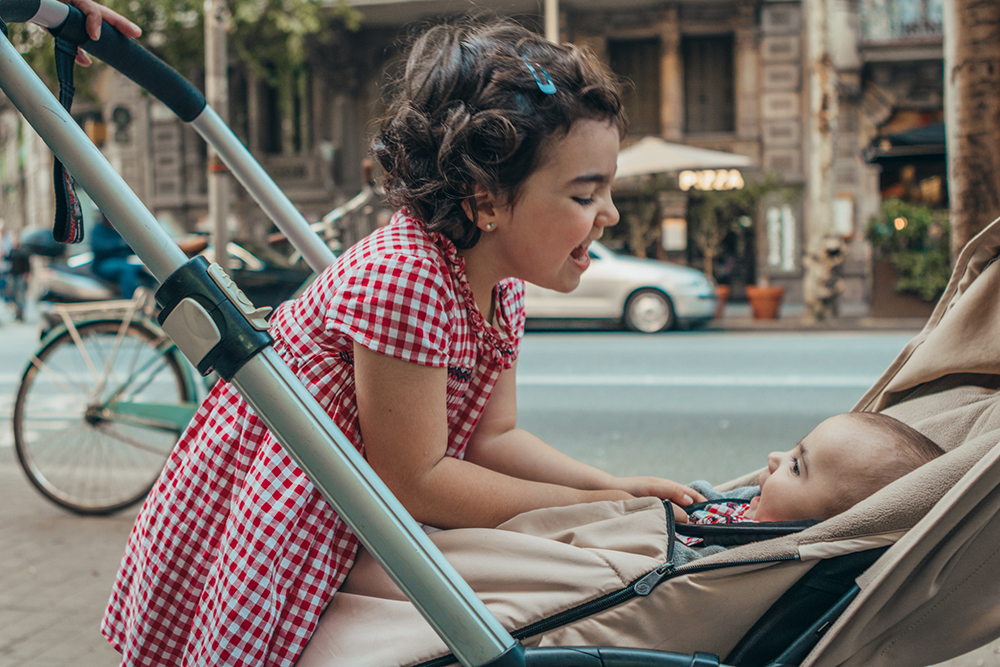Should You Have a Second Baby?

Adding another family member to the mix is always a big deal, but for new-again mamas, it's a different, often more-relaxed, rodeo.
A high school teacher in Clarksburg, Maryland, and contributor to the parenting blog Diary of a First Time Mom, Kerrin Torres-Meriwether understands the long and short of sibling age gaps more fully than most. She and her twin sister were born just two minutes apart—they grew up as side-by-side playmates and remain best friends. On the other hand, there are 19 years between her and her youngest brother. While the two are close, she says, their relationship can’t draw on the bonds of shared childhood memories.
The perfect time for birth spacing, she decided, must be somewhere between those extremes. So when Torres-Meriwether had her first child, a son named Jailen, she and her husband planned to have their next baby around four years later. The siblings would still be close enough in age to play together, they reasoned, but not so close that the couple would be changing two sets of diapers, or eventually footing two college tuition bills, at once.
But things don’t always go according to plan—especially when babies are involved—and her daughter, Kerrigan, was born when Jailen was a 2-year-old, making him technically an older brother, but not so much an older child.
“We had no plans to have another one so soon,” she recalls. “When Kerrigan was born, [Jailen] was still a baby to us. But now, he’s really taken to the big brother role.”
While there’s no simple formula for determining how much space is just enough space between babies, it helps to start by taking an honest look at whether you, your body and your family are really ready to try for another.
Preparing Your Body
According to a report from the Centers for Disease Control and Prevention on interpregnancy intervals, nearly 30 percent of American women get pregnant again within 18 months of giving birth. But for all women, that might not be enough time to restore depleted nutrients and recover from the physical stress of pregnancy.
Waiting a little longer can help reduce health problems for both mom and baby, suggest medical experts, including Robert Atlas, MD, chairman of obstetrics and gynecology at Mercy Medical Center in Baltimore.
“At least 18 to 24 months between pregnancy spacing is optimal,” Atlas advises. “Too many back-to-back pregnancies can be associated with anemia and premature birth.”
Other health care risks associated with closely spaced pregnancies include increased risk of low birth weight and pregnancy complications.
Atlas stresses the importance of inter-conception care—discussing your family planning with your doctor between pregnancies so that whenever you decide the time is right, your body will be in good shape for your next pregnancy.
“Talk to your OB/GYN beforehand,” he advises. “What medical conditions do you have? Are you taking any medications, and are they safe during pregnancy? Do you need to make a plan for exercise and weight loss? Doing things to improve your health prior to conception is helpful.”
Preparing Your Mind
When contemplating a new addition, your mental health is just as important as your physical health, notes Laura Markham, PhD, author of Peaceful Parent, Happy Siblings: How to Stop the Fighting and Raise Friends for Life.
Many parents plan to have their children within a year or two of each other, in part to get through the breastfeeding-diapering-up-all-night infant period all at once, she says.
Although it’s possible for two-baby households to thrive, Markham knew that, for her, the arrangement wasn’t ideal. The stress and sleeplessness of the postpartum period would have made it difficult to be a fully responsive parent to both children. She didn’t have another child until her first baby was four.
“Part of the decision involves knowing you’ll have enough energy to be the kind of parent you want to be,” Markham explains. “I knew I would be a better mom if I spaced my kids farther apart.”
Listen to your instincts, adds Anna Lazo, PsyD, a licensed clinical psychologist in Oakland, California. “Maybe you always had these hopes and dreams that you would have two children, two years apart. You’re allowed to change your mind. Accept where you are at that time—it’s a very personal decision that’s really different for every family.”
Preparing Your Family
As soon as they knew another baby was on the way, Torres-Meriwether and her husband started talking to only child Jailen about his sibling-to-be.
“We tried to really involve him in the process,” she says. “When Kerrigan finally arrived, he wasn’t surprised, and it wasn’t as challenging a transition as we thought it was going to be.”
Sibling dynamics are yet another factor in the baby-spacing equation, and Markham reassures parents that lifelong friendships among brothers and sisters are possible regardless of how many years separate your children. Just keep in mind the pros and cons associated with wide and slim age gaps.
“Siblings spaced closer together are more likely to bond more deeply,” Markham says. “As a family, you’ll likely have more coherence—the same movies are of interest to both children, you can all take part in the same conversations around the dinner table.”
But children close-in-age also tend to experience more sibling rivalry. “As long as parents handle the fighting well, what the kids will remember in the end is the love and affection, not the fighting,” Markham assures.
Meanwhile, when children are spaced farther apart, they fight less, and older siblings are less likely to experience bouts of jealousy. They’re also more likely to have a life outside the home—they go to preschool, play sports or have neighborhood friends, for example—which can help ease demands on your attention.
But, Markham adds, “Your kids will not automatically play together. You’ll have to work harder to build a bond.” Torres-Meriwether’s children are now 4 and 2, and she says that, although they’re closer in age than she originally planned, she cherishes the friendship blossoming between them.
“The other day they were sitting on the ground together with some toy trucks. Kerrigan was just banging them on the floor until Jailen came over and showed her how to roll them. He really looks out for her.”







